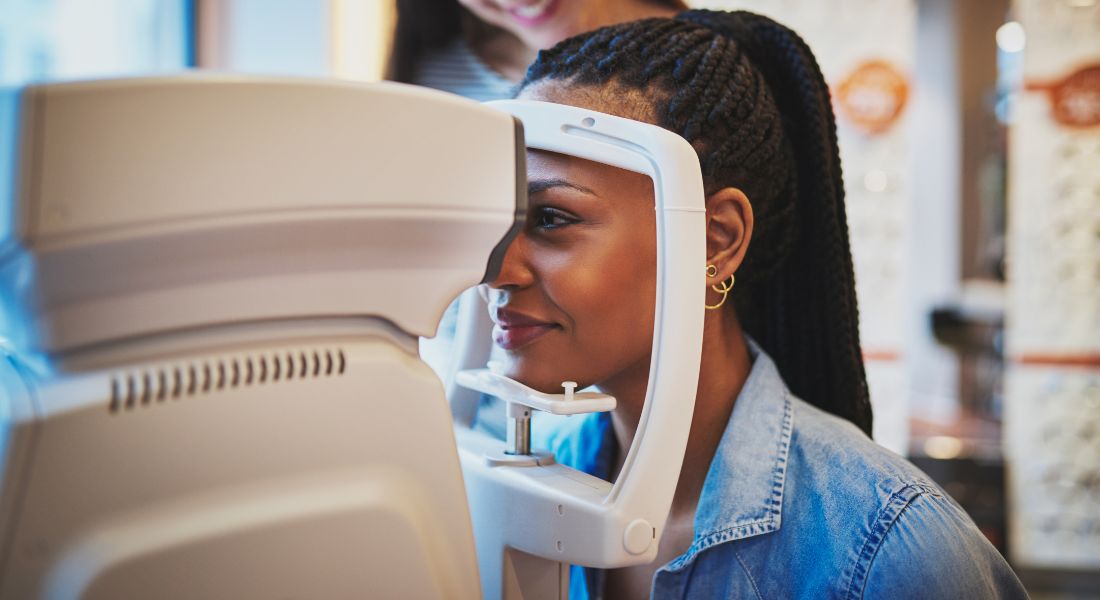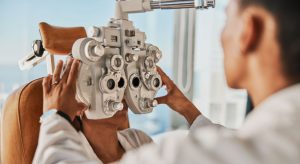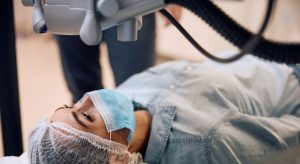LASIK Surgery for High Prescriptions: What Are the Limits?

If you have a high glasses prescription, you may be wondering whether LASIK can actually correct it. Many people with strong myopia, hyperopia or astigmatism assume they’re automatically excluded from laser eye surgery but that’s no longer true. Modern LASIK technology has come a long way, and today, many high-prescription patients can safely enjoy clearer, glasses-free vision.
At the same time, there are limits to what LASIK can correct safely. Corneal thickness, prescription strength and long-term stability all have to be taken into account. And in some cases, alternative treatments like ICL surgery may give you a better and more accurate result. My goal in this article is to guide you through exactly where those boundaries lie so you can understand your options clearly.
By the end of this guide, you’ll know how high your prescription can be for LASIK, what factors determine eligibility and when another approach may be safer. That way, you’ll feel confident about taking the next step in your vision correction journey.
What Counts as a High Prescription?

Before we look at LASIK limits, it’s important to understand what high prescriptions typically include.
High Myopia (Short-Sightedness)
- More than -6.00 dioptres
- Some clinics consider -8.00 or higher “very high myopia”
High Hyperopia (Long-Sightedness)
- More than +4.00 dioptres
High Astigmatism
- More than 3.00 dioptres
If your prescription falls near or beyond these ranges, you’re considered a high-prescription patient.
How LASIK Works (And Why There Are Limits)
LASIK improves your vision by reshaping your cornea with an excimer laser. The amount of reshaping needed depends on your prescription strength.
Higher prescriptions require:
- More corneal tissue removal
- Greater reshaping
- More laser time
This means your surgeon must ensure your corneas remain thick and strong enough after surgery to remain healthy for years to come.
LASIK Limits for Myopia, Hyperopia, and Astigmatism
Myopia (Short-Sightedness): Limit ≈ -10.00D
Most clinics treat myopia up to:
- -8.00D to -10.00D, depending on corneal thickness
Some people with very stable corneas can be treated beyond -10.00D using conservative ablation patterns, but it’s rare.
Hyperopia (Long-Sightedness): Limit ≈ +4.00D
Hyperopic laser correction is more limited than myopic correction. The safe upper limit is generally:
- +4.00D, sometimes +5.00D in selected patients
Anything higher risks regression or unstable results.
Astigmatism: Limit ≈ 4.00D
Most LASIK platforms treat up to:
- 3.00D to 4.00D of astigmatism
Higher levels can be corrected, but the corneal shape must be extremely stable.
Why LASIK Has These Limits

LASIK works by removing precise amounts of corneal tissue to reshape the eye and correct refractive errors. While the procedure is highly effective, there are natural limits to how much tissue can safely be removed. The main concern is maintaining the structural integrity of the cornea. If too much tissue is removed, the cornea can become weakened, which may lead to long-term complications such as corneal ectasia, irregular astigmatism, or reduced visual stability.
Two key measurements play a crucial role in determining whether a patient is a suitable candidate for LASIK:
- Corneal Thickness (Pachymetry):
This measurement indicates how thick your cornea is. Thicker corneas can tolerate more tissue removal, which allows surgeons to correct higher prescriptions safely. Conversely, thinner corneas limit the amount of laser correction possible because there is less tissue to work with, increasing the risk of weakening the eye. Pachymetry is usually measured in microns, and precise mapping of the cornea ensures that the laser removes only the necessary tissue while leaving enough behind for a strong and stable structure. - Residual Stromal Bed (RSB):
The residual stromal bed is the layer of corneal tissue that remains after the laser reshaping is complete. Maintaining a safe RSB is essential to prevent corneal instability. Most surgeons consider a minimum RSB of 250–300 microns to be safe, although this can vary depending on individual corneal characteristics. If the RSB is too thin, the cornea may bulge or weaken over time, potentially causing visual problems or complications that may require further intervention.
By carefully evaluating these two factors, along with overall eye health and prescription strength, surgeons can determine the safest approach for LASIK and ensure the best long-term outcomes for patients.
Factors That Determine Whether You Qualify for LASIK
Even if your prescription is high, you may still qualify depending on other factors.
Corneal Thickness
You need a thick enough cornea to safely remove the necessary tissue. Thicker corneas allow higher prescriptions.
Corneal Shape
Corneal topography and tomography scans detect:
- Irregularities
- Keratoconus
- Early ectasia
- Warpage from contact lenses
Irregular corneas are not suitable for high-prescription LASIK.
Prescription Stability
Your glasses or contact lens prescription must be stable for at least one year. High prescriptions require extra caution.
Pupil Size
Large pupils can increase halos and glare something high-prescription LASIK patients should consider.
Tear Film Health
Dry eye increases after LASIK, especially for higher levels of correction. You may still qualify, but treatment may be needed before surgery.
Age
Most surgeons prefer treating high prescriptions in people:
- Over 21
- With stable prescriptions
- Without rapid changes in vision
What Happens If Your Prescription Is Too High for LASIK?
If LASIK isn’t suitable, there are alternative vision correction options that work brilliantly for high prescriptions.
Let’s explore them.
Alternative Options for High Prescriptions
ICL Surgery (Implantable Contact Lens)
Many high-prescription patients who can’t have LASIK choose ICL surgery.
Why ICL is ideal for high prescriptions:
- Treats very high myopia (up to -20.00D or more)
- Treats high astigmatism
- Preserves corneal thickness
- No tissue removal
- Reversible
ICL is often the best option for thin corneas or extremely high prescriptions.
SMILE Surgery
SMILE is another great option for strong prescriptions.
Benefits of SMILE for high myopia:
- No corneal flap
- Less dryness
- Less impact on corneal strength
- Treats up to around -10.00D depending on platform
Some patients who don’t qualify for LASIK can qualify for SMILE.
PRK (Photo-Refractive Keratectomy)
PRK does not involve a flap and preserves more corneal thickness.
Why PRK helps:
- Suitable for slightly higher prescriptions
- Ideal for thin corneas
- Great for active lifestyles
Healing takes longer than LASIK, but long-term results are excellent.
Can LASIK Make High Prescriptions Worse?
LASIK doesn’t worsen your prescription, but treating high prescriptions requires careful assessment.
Potential issues include:
- Increased dryness
- Night halo sensitivity
- Higher chance of regression
- Thinner residual cornea
Careful planning reduces these risks dramatically.
Benefits of LASIK for High Prescriptions
If you qualify, LASIK can transform your life even more dramatically than for lower prescriptions.
You may enjoy:
- Complete glasses freedom
- Better peripheral vision
- Better safety for sports
- A lighter, more comfortable lifestyle
- Clearer vision from morning until night
High-prescription patients often report the most emotional impact from the results.
Risks to Consider Before LASIK for High Prescriptions
You should be aware of potential risks, especially at higher correction levels.
These include:
- Night glare or halos
- Dryness
- Regression
- Thinning of the cornea
- Rare risk of ectasia
These risks are minimised through modern screening and conservative treatment plans.
How Surgeons Decide the Best Option for You
You will undergo several scans and assessments:
- Corneal tomography
- Pachymetry
- Wavefront analysis
- Pupil measurement
- Tear film evaluation
- Prescription stability check
These tests help determine whether LASIK or another option is safest.
What to Expect If You Have High-Prescription LASIK

During the procedure:
- Numbing drops applied
- Laser takes seconds
- No pain
- Mild pressure sensation
After the procedure:
- Blurry vision for a few hours
- Clear vision by next morning
- Light sensitivity initially
- Dryness improves over months
Most patients achieve excellent clarity very quickly.
Night Vision and High Prescriptions
Night glare and halos are more common in high prescriptions, especially if:
- Your pupils are large
- The treatment zone is smaller
- Your cornea heals unevenly
Blade-free LASIK with larger optical zones reduces these issues significantly.
LASIK vs ICL for High Prescriptions: Which Is Better?
Here’s a simple comparison.
LASIK is better if:
- Your corneas are thick
- Your prescription is within safe range
- You prefer a flap-based procedure
- You want fast recovery
ICL is better if:
- Your prescription is very high
- Your corneas are thin
- You want a reversible option
- You have dry eyes
- You’re not suitable for LASIK
Many surgeons see ICL as the premium solution for very high prescriptions.
FAQs:
- Can LASIK correct very high prescriptions?
LASIK can correct a wide range of prescriptions, but there is a point at which the surgery becomes unsafe because too much corneal tissue would need to be removed. Most clinics safely treat myopia up to around -8.00D to -10.00D, hyperopia up to +4.00D and astigmatism up to about 4.00D. If your prescription goes beyond these limits, it doesn’t mean you cannot achieve clear, glasses-free vision—it simply means another procedure such as ICL surgery or SMILE may be a better match for your eyes. - Why can’t LASIK treat extremely high myopia?
Extremely high myopia requires a large amount of corneal reshaping, and this can thin the cornea more than is safe. Your surgeon must always leave a strong layer of tissue behind to maintain the long-term health and stability of your eye. If your prescription would require removing too much tissue, then LASIK becomes unsuitable—not because the treatment can’t correct the power, but because it could compromise the strength of your cornea in the future. - Is LASIK safe if I have thin corneas?
Thin corneas are one of the main reasons someone may not qualify for LASIK. The procedure requires removing a precise layer of tissue, and if the cornea starts out thin, the remaining tissue may not be enough to keep the eye structurally stable. In these cases, surgeons often recommend SMILE, PRK or ICL surgery because these options preserve more corneal tissue and are considered safer for long-term visual results. - Can LASIK cause regression for high prescriptions?
Regression is more likely when treating higher prescriptions simply because the cornea has to undergo more reshaping. Although most patients maintain excellent long-term vision, a small percentage may notice a slight shift back toward their original prescription months or years later. This doesn’t mean the procedure failed; rather, it reflects how the eye heals and adapts. Enhancements are possible in many cases, and alternatives like ICL surgery have an even lower risk of regression for very high powers. - Is LASIK suitable for high astigmatism?
LASIK can correct astigmatism very effectively, but only up to a certain level. Most modern laser systems treat up to around 3.00D to 4.00D, although the exact limit depends on corneal shape and stability. The procedure works by reshaping the cornea in a way that evens out the irregular curvature. If your astigmatism is higher than the treatable range, surgeons often prefer ICLs or a combined approach because these methods deliver more predictable results. - Does LASIK recovery take longer for high prescriptions?
Recovery after LASIK is generally quick, but high-prescription patients may notice slightly more dryness, fluctuating vision or night halos during the first few weeks. This is because the cornea undergoes more reshaping to achieve the desired correction. Even so, most people still see very clearly within 24 hours. The overall healing timeline remains similar, but full visual stability may take a bit longer compared to someone with a mild prescription. - Is ICL surgery better than LASIK for very high prescriptions?
ICL surgery is often the preferred option for high prescriptions because it doesn’t remove any corneal tissue. Instead, a thin lens is placed inside the eye to correct the refractive error. This makes it ideal for people with thin corneas, dry eyes or extreme myopia, even up to -20.00D or more. Many surgeons consider ICL surgery the safest and most accurate choice for strong prescriptions because the results are stable, high-definition and reversible. - Can high-prescription patients still develop night glare after LASIK?
Night glare can occur in any LASIK patient, but it is more noticeable when treating stronger prescriptions. This is because the ablation zone needs to be larger, and the cornea may take longer to settle. Modern wavefront and topography-guided technologies reduce the likelihood of night glare significantly by smoothing out subtle irregularities in the corneal surface. In most cases, any visual halos that appear early on continue to improve as the eye heals. - Will LASIK make my corneas too thin?
LASIK only becomes risky when the surgery would leave the cornea thinner than the recommended safety threshold. This is why your surgeon performs corneal mapping and thickness measurements before determining whether LASIK is appropriate for you. If the calculations show that the procedure would leave insufficient tissue, LASIK is simply avoided, and you are guided toward a safer alternative rather than proceeding with a risky approach. - What is the best option if I’m not suitable for LASIK due to a high prescription?
If LASIK isn’t suitable for your eyes, there are still excellent options available. ICL surgery is often the top choice for very high prescriptions because it provides strong, stable correction without affecting corneal thickness. PRK is a good alternative for moderately high prescriptions or thin corneas, while SMILE is ideal for certain ranges of myopia with less impact on corneal nerves. The right choice depends entirely on your eye structure, prescription levels and long-term visual goals.
Final Thought: Choosing the Best Vision Correction for High Prescriptions
High-prescription patients no longer have to assume that glasses or contact lenses are their only option. While LASIK has clear limits based on corneal thickness, prescription strength, and overall eye health, modern laser technology has expanded the number of people who can safely benefit from this procedure. For prescriptions beyond LASIK’s safe range, alternatives such as ICL surgery, SMILE, or PRK offer effective and predictable vision correction while preserving corneal integrity.
If you’re exploring whether Lasik surgery in London could benefit you, get in touch with us at Eye Clinic London to schedule your consultation. A detailed assessment will help you understand which treatment is safest and most effective for your long-term visual goals. With the right approach, achieving clearer, glasses-free vision is well within reach.
References:
- Kanclerz, P. & Khoramnia, R. (2021) ‘Flap Thickness and the Risk of Complications in Mechanical Microkeratome and Femtosecond Laser In Situ Keratomileusis: A Literature Review and Statistical Analysis’, Diagnostics, 11(9), 1588. Available at: https://www.mdpi.com/2075-4418/11/9/1588
- Juda, M. et al. (2024) ‘Clinical Evaluation of Corneal Endothelial Parameters Following Laser Refractive Surgery in Myopic Patients: A Review’, Journal of Clinical Medicine, 13(6), 1665. Available at: https://www.mdpi.com/2077-0383/13/6/1665
- Santhiago, M. R. et al. (2015) ‘Role of Percent Tissue Altered on Ectasia After LASIK in Eyes With Suspicious Preoperative Corneal Topography’, Clinical Ophthalmology, 9, pp. 1695–1701. PubMed [no DOI]. Available at: https://pubmed.ncbi.nlm.nih.gov/25884581/
- Twelve-year follow-up of laser in situ keratomileusis for moderate to high myopia study group (2017) ‘Twelve‑Year Follow‑Up of Laser In Situ Keratomileusis for Moderate to High Myopia’, Journal of Refractive Surgery, 33(5), pp. 330–334. PubMed. Available at: https://pubmed.ncbi.nlm.nih.gov/28596969/
- Harissi‑Dagher, M., Frimmel, S. A. F. & Melki, S. (2009) ‘High myopia as a risk factor for post‑LASIK ectasia: a case report’, Digital Journal of Ophthalmology, 15(1), pp. 9–13. PMC article. Available at: https://pmc.ncbi.nlm.nih.gov/articles/PMC5735597/

